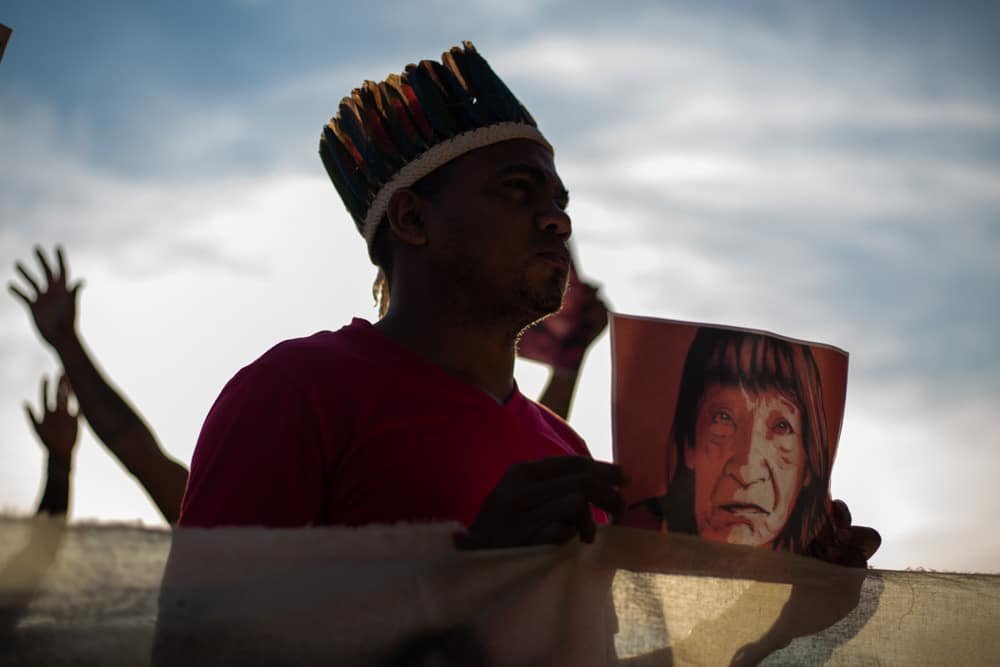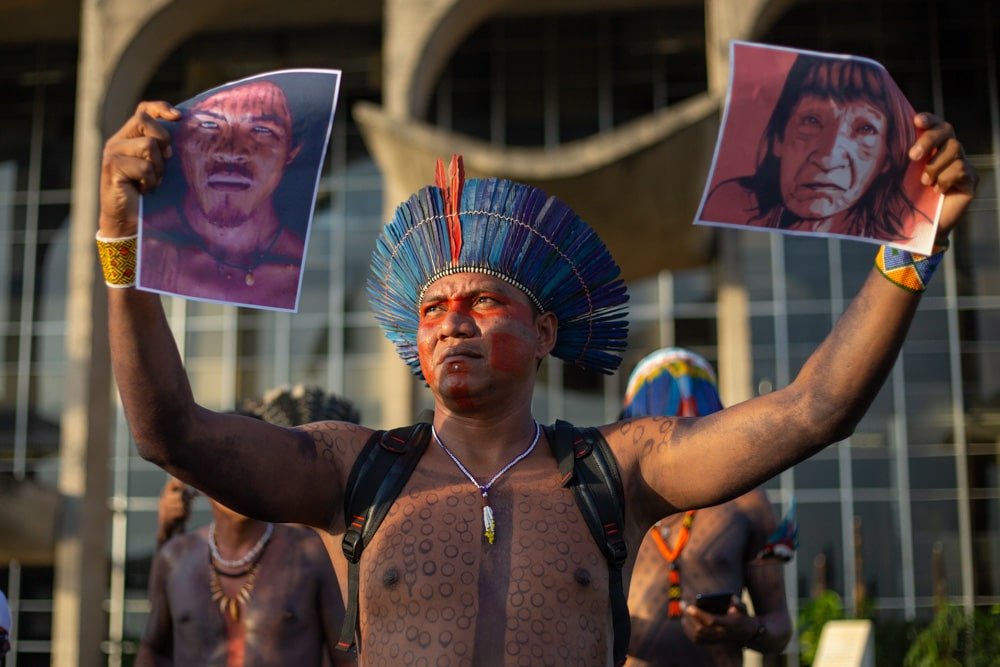Maranhão State
AMAZON REGION
The Araribóia Indigenous Land encompasses the municipalities of Arame, Buriticupu, Amarante do Maranhão, Bom Jesus das Selvas, and Santa Luzia, located in southern Maranhão state, in the transition area between the Cerrado and the Amazon regions. Totaling 413,288.0472 hectares, the territory was demarcated in 1982 and formally registered in 1990[1]. It is home to 9,481 indigenous[2] persons from the Tenetehara/Guajajara and Awá-Guajá peoples, the latter uncontacted.
A member of the Tupi-Guarani family, the Guajajara people are spread throughout more than ten indigenous lands in Maranhão state, distributed along the Amazon’s eastern border – in the state’s central region. For them, contact with non-indigenous people has had devastating effects, with stories of massacres, enduring persecution, and eviction from the territories.[3] Their agriculture consists of cassava, manioc, corn, rice, pumpkin, watermelon, among others. Fishing is also practiced along riverside areas. Their social organization is based on a kinship system, characterized by the extended family structure. As a result of continuous contact with non-indigenous society, many aspects of their culture have been modified or even lost, like chants, rituals such as the honey ritual, the corn ritual, the moqueado ritual, also known as the “festa da menina moça” [young-woman-festival], among others.
The presence of the Awá people in the Araribóia Indigenous Land was confirmed in 2004 by the General Coordination of Isolated and Newly Contacted Indigenous Peoples (Coordenação Geral de Índios Isolados e Recém Contatados, CGIIRC), although the Tenetehara/Guajajara people have met with them on various occasions. Over the years, the Awá-guajá people of the Araribóia Indigenous Land have endured a process of violence in connection with the ongoing land invasions by logging enterprises. In 2012, teams from the Indigenist Missionary Council (Conselho Indigenista Missionário, CIMI) of Maranhão state, and the Brazilian Bar Association Human Rights Commission, visited the area to investigate a complaint, lodged by the leaders of the Tenetehara/Guajajara peoples, about the murder of an Awá-guajá child by a logger.[4] Sadly, the child’s body was never found. A tapiri, a cabin used for temporary shelter by the Awá people, was found in the vicinity of the roads that connect to the logging channels and the loggers’ encampments. There is, therefore, reason to believe that non-peaceful encounters with loggers who invade the territory constitute an existential threat to the indigenous people who inhabit the area.
This scenario of ongoing invasions leads to food shortages for the Awá people of the Araribóia Indigenous Territory, placing them in a situation of extreme vulnerability. As a result, the once isolated indigenous people have been approaching the villages of the Tenetehara/Guajajara people in search of food. Olimpio Guajajara, coordinator of the guardians of the forest group, reports:
Notes
Censo IMP/DSEI – MA.
“Conflito histórico no Maranhão ganha novo capítulo” [New Chapter in Maranhão’s Historical Conflict.”] Correio Brasiliense, 12/15/2019.
Porantim\2012\Xxxiv no. 342 – January/February-12
The historical process of violence, fires, and invasions of the territory
Deforestation for illegal logging has been a constant in the territory. Data from the Socio-environmental Institute (Instituto Socioambiental, ISA) illustrate that, by 2020, at least 24,825 hectares had suffered deforestation in Araribóia.[5] Faced with this situation of brazen illegality, indigenous leaders have confronted the invasions.
Following numerous complaints, a February 2021 joint-action by the Federal Police (PF) and other protection agencies confirmed what the indigenous peoples have been repeatedly voicing: the ongoing looting of their forests to supply the illegal timber trade. The Federal Police has identified several deforestation points, as well as sawmills and furniture workshops within the territory. One of the objectives of the operation against illegal logging in the Araribóia Indigenous Land is precisely to protect the Awa-guajá people in isolation, preventing their contact with loggers and potential infection with the new coronavirus.[6]
Illegal logging goes hand-in-hand with violence against those who act in defense of the territory. Data from the Violence Report published annually by CIMI indicate that in the 2000s at least 48 indigenous Guajajara people were assassinated – 47 in Maranhão state and one in Pará state. 2019 was the year with the fourth highest numbers of assassinations, with six cases identified until December 19, including that of Erisvan Guajajara, 15, killed in the town of Amarante. The years of 2007 and 2016 witnessed the highest number of Guajajara assassinations, recording 10 cases each, followed by 2012, with seven cases.[7]
One of the cases that earned extensive national and international notoriety was the assassination on November 1, 2019 of forest guardian Paulino Guajajara, killed in an ambush by territory invaders. Paulino had received death threats and was negotiating his entry into a state program for the protection of human rights defenders.[8]
Notes
“Operação fecha serrarias em área da Terra Indígena Arariboia, no MA” [“Operation shuts down sawmills in the Arariboia Indigenous Land, in MA.”] G1, 02/10/2021.
The Caci – Cartografia dos Ataques Contra Indígenas [Cartography of Attacks against Indigenous People] Platform is an important data source on the assassinations of indigenous people.
The data are systematized by CIMI and also by Comissão Pastoral da Terra [Pastoral Land Commission] (CPT).
See also: “Povo Guajajara resiste às invasões territoriais e registra 48 assassinatos em menos de 20 anos” [“Guajajara people resist territorial invasions and register 48 assassinations in less than 20 years.”] CIMI, 03/02/2020. Available at:
“Assassinato de líder Guajajara abala comunidade indígena e Moro garante que PF vai investigar” [Murder of Guajajara leader shakes indigenous community and Moro attests that Federal Police will investigate.”] El País, 11/02/2019.
See: “‘Gente estranha tirou a vida do meu pai’, diz Aikyry Wajãpi” [“‘Strange people took my father’s life,’ says Aikyry Wajãpi.”] Amazônia Real. 09/10/2019
In July 2007, following the invasion of Lagoa Comprida village (approximately eighty kilometers from Amarante do Maranhão), in which women were taken hostage and Tomé Guajajara was murdered,[10] loggers set the forest on fire, starting a large-scale fire in the region.[11] It was the first large-scale criminal fire taking place on the indigenous land. Since then, criminal fires have been a regular occurrence. Hence, in addition to the issues of violence perpetrated against indigenous people and land invasions for illegal logging, the territory endures annual fires.
In 2015, a major criminal fire started by loggers spread throughout the land. Until September of that year, the National Center for the Prevention and Combat of Forest Fires (PrevFogo) registered 374 fire outbreaks in the Araribóia Indigenous Land. According to data released by Prevfogo in March 2016, 225 thousand hectares (54.4% of the total area) of the Araribóia Indigenous Land were consumed by the fires.[12] At the time, an agent of the Brazilian Institute of Environment and Renewable Natural Resources (Instituto Brasileiro do Meio Ambiente e dos Recursos Naturais Renováveis, Ibama) was wounded in a gunfire exchange with land invaders.[13]
In 2017, another major fire outbreak in the region raised concerns for the Guajajara and Awá-guajá peoples, who were still recovering from the fires of 2015 and 2016. Leader Frederico Guajajara reported that crop plots had been lost, wild animals hunted for food had once again disappeared, harvesting in the forest was no longer possible, and water sources were drying up with each fire:
In 2019, another major fire in the Araribóia Indigenous Land endangered Guajajara villages and the free Awá people.[15].
Resistance
In 2008, indigenous leaders formed a territory protection group known as the Guardians of the Forest, which has been engaged in fighting invasions and fires in the Araribóia Indigenous Land.
“The main mission of the group is to defend the Araribóia Indigenous Land from the illegal exploitation of natural resources, by carrying out environmental and territorial monitoring to ensure that the Tenetehar and Awá Guajá peoples have all the necessary conditions for their physical and cultural reproduction”, as per letter from the Guardians of the Forest group denouncing the logger invasions to public agencies.
The fires continue to happen,[16] now on a smaller, but no less concerning scale, as they affect the territory where the free Awá people live.[17] The indigenous leaders also express concern about the fires because they are responsible for decimating animals that are used for food and in indigenous cultural rituals.
Notes
This and other information pertaining to the violence inflicted against the Guajajara people. Mapa de Conflitos [Map of Conflicts], Fiocruz.
“Ibama team is attacked and shot at by illegal loggers in Maranhão, Brazil.” Infoamazônia, 10/27/2015.
“Sobrevoo mostra incêndio na terra indígena Arariboia, no Maranhão” [“Flyover shows fire outbreak in the Arariboia Indigenous Land in Maranhão.”] G1, 10/28/2015. Available at:
Pelo 3º ano seguido, incêndio na TI Arariboia pode provocar remoção de Awá isolados e destruição de aldeias Guajajara [For the 3rd year in a row, fire outbreak in the Arariboia Indigenous Land can lead to the departure of uncontacted Awá people and the destruction of Guajajara villages]. CIMI, 09/29/2017.
“Queimada chega à TI Arariboia e coloca em risco aldeias Guajajara e povo Awá-Guajá livre” [“Fires reach the Arariboia Indigenous Land placing Guajajara villages and the uncontacted Awá-Guajá people at risk.”] CIMI, 09/24/2019.
The data is concerning, considering the context of the COVID-19 pandemic in a country that does not provide indigenous people with adequate health care. “Desmatamento aumenta 827% em terra indígena no período da pandemia” [“Deforestation in indigenous land increased by 827% during pandemic”] – CartaCapital
“Em 2020, povos indígenas isolados são acossados por queimadas, violência e pandemia” [“In 2020, isolated indigenous peoples are beset by fires, violence and a pandemic.”] ISA, 12/23/2020.
adopt the necessary measures to protect the rights to health, life, and personal integrity of the members of the Guajajara and Awá Indigenous Peoples of the Araribóia Indigenous Land, implementing, from a culturally appropriate perspective, preventive measures against the spread of COVID-19.[18].
It is urgently necessary to put in place a continuous surveillance plan for the Araribóia Indigenous Land, with the active participation of different government spheres and indigenous people. Should this not be effected, the forest and the lives that depend on it run the risk of being reduced to chaos.
Notes
Gilderlan Rodrigues da Silva is a member from the Conselho Indigenista Missionário/CIMI [Indigenist Missionary Council] – Maranhão section.
Lucimar Ferreira da Silva is a Legal Advisor for the CIMI – Maranhão section.








